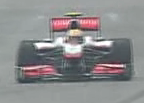747heavy wrote:a "semi automatic" system which stall above a certain speed, indepentend from the driver action is technically possible - IMHO
One drawback, is you would lose braking performance at high speed IMO, as the drag of the wing would be most benefical at max speed. A speed sensitive system would only "switch on" the df/drag below the reference speed, so you lose the effect at higher speeds, this would also affect the brake balance.
With a purely speed sensitive system you would lose the advantage in the first part of the straight, until you reach your activation speed.
It´s doable, sure, but I would see the behavior in brakeing as a "problem"/drawback
Good points, but I am merely pointing out that many posters on here, and indeed it seems the overwhelming majority of journalists still insist on saying that McLaren use their "left knee" or "left leg" but the fact is, McLaren have managed to keep this particular fact a secret, despite all the other teams being in a position to copy it in their own way.
This could be and probably is a bit of one-upmanship on the part of McLaren, but if the reason for their keeping this "secret" so close to their chest is that whatever they are doing does indeed give them an "advantage", then that would suggest to me that perhaps their car would be significantly off the pace were it not for whatever "secret" this actually is?
The answer to the ultimate question, of life, the Universe and ... Everything?




